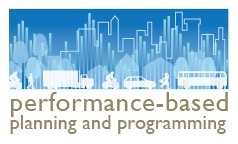Home » Our Work » Performance-based Planning and Programming
 The Boston Region MPO envisions an equitable, pollution-free, and modern regional transportation system that gets people to their destinations safely, easily, and reliably, and that supports an inclusive, resilient, healthy, and economically vibrant Boston region.
The Boston Region MPO envisions an equitable, pollution-free, and modern regional transportation system that gets people to their destinations safely, easily, and reliably, and that supports an inclusive, resilient, healthy, and economically vibrant Boston region.
-Destination 2050 Vision
On October 20, 2022, the MPO board voted to adopt a set of updated performance targets pertaining to the Congestion Mitigation and Air Quality Improvement (CMAQ) program. These include targets related to non-single-occupancy travel, person-hours of excessive delay, and emissions reductions from CMAQ-funded projects. These targets reflect two-year and four-year time horizons. For more information about these CMAQ performance measures, targets, and related processes, please refer to the memorandum titled CMAQ Mid-Performance Period Report, October 2024 (PDF) CMAQ Program Performance Targets-2022 (HTML).
|
Geographic Area |
2017 Measure Value |
Two-Year Target |
Four-Year Target |
|---|---|---|---|
|
Boston Urbanized Area |
18.0 |
24.0 |
22.0 |
CY = calendar year. FHWA = Federal Highway Administration. MA = Massachusetts. MPO =
metropolitan planning organization. NH = New Hampshire. RI = Rhode Island. UZA = urbanized area.
Sources: National Performance Management Research Data Set, US Census Bureau, FHWA, the
Massachusetts Department of Transportation, the New Hampshire Department of Transportation,
Cambridge Systematics, and the Boston Region MPO staff.
|
Geographic Area |
Baseline Value |
Two-Year Target |
Projected Two-Year Target |
|---|---|---|---|
|
Boston UZA |
36.9% |
38.8% |
39.8% |
Note: Values in this table reflect five-year rolling averages for the percent of non-SOV travel to work.
CY = calendar year. MA = Massachusetts. NH = New Hampshire. Non-SOV = non-single-occupancy vehicle. RI = Rhode
Island. UZA = urbanized area.
